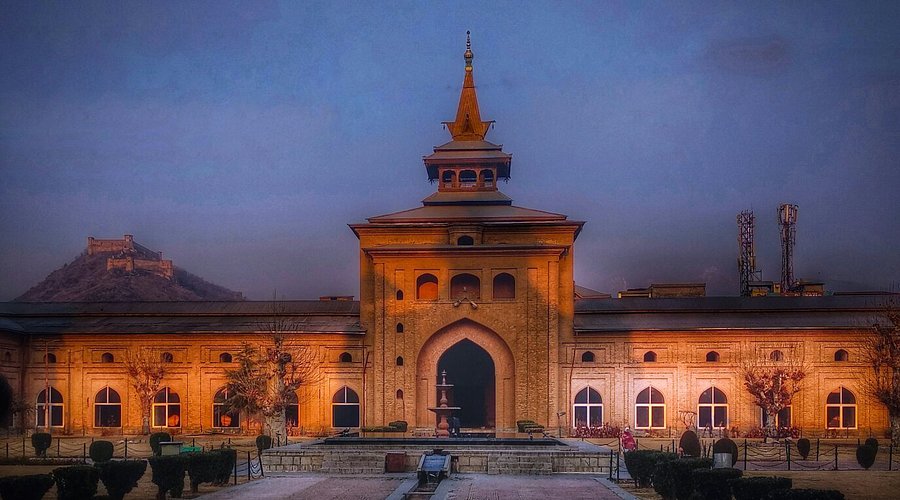Jamia Masjid Srinagar Guide: History, Tips, and Tour Package
Nestled in the heart of Srinagar’s old city, Jamia Masjid stands as a testament to Kashmir’s rich cultural heritage and architectural brilliance. Built in 1402 CE by Sultan Sikandar, this majestic mosque is not just a place of worship but a symbol of resilience, harmony, and artistic ingenuity. With its towering deodar wood pillars, sprawling courtyard, and Indo-Saracenic design, Jamia Masjid offers visitors a glimpse into Kashmir’s soul—a place where silence speaks volumes through its wooden grandeur and historical significance[i].
A Journey Through History
Jamia Masjid was commissioned by Sultan Sikandar in 1394 CE and completed in 1402 CE under the guidance of Mir Mohammad Hamadani, son of the revered Persian saint Mir Sayyid Ali Hamadani. Over the centuries, the mosque has witnessed numerous reconstructions due to fires in 1479, 1620, and 1674, each time rising from the ashes with renewed splendor. Its enduring legacy is a reflection of Kashmir’s unwavering spirit, making it a must-visit destination for history enthusiasts and spiritual seekers alike[ii].
Architectural Marvel
Unlike the red sandstone mosques of Mughal India, Jamia Masjid boasts a unique blend of Persian, Central Asian, and Kashmiri architectural styles. Key features include:
- 378 Deodar Wood Pillars: These towering pillars, each 21 feet high, support the mosque’s structure and create a mesmerizing symmetry.
- Pyramidal Roof: Designed to withstand heavy snowfall, the sloping roof is adorned with wooden tiles, adding to the mosque’s rustic charm.
- Spacious Courtyard: The courtyard can accommodate up to 33,333 worshippers, making it one of the largest mosques in Kashmir.
- Four Turrets: These corner turrets, topped with pyramidal roofs, offer panoramic views of Srinagar and are interconnected by spacious halls.
The mosque’s design prioritizes functionality and spirituality, with minimal ornamentation that emphasizes simplicity and tranquility[iii].
Cultural and Spiritual Significance
Jamia Masjid is the epicenter of religious life in Kashmir. Every Friday, thousands of devotees gather here for congregational prayers, creating an atmosphere of unity and devotion . The mosque also plays a vital role during Islamic festivals like Eid and Ramadan, where the courtyard comes alive with prayers and celebrations. Beyond its religious significance, Jamia Masjid has been a platform for socio-political discourse, reflecting the region’s complex history[iv].
Visitor Experience
Visiting Jamia Masjid is a sensory journey. As you step into its courtyard, the hustle of Nowhatta’s bustling markets fades away, replaced by a profound sense of peace. The aroma of aged wood, the sight of sunlight filtering through the pillars, and the sound of prayers create an unforgettable experience. Visitors are advised to:
- Dress modestly and remove shoes before entering.
- Avoid visiting during prayer times (especially Fridays) unless participating in worship.
- Explore nearby attractions like the Khanqah of Shah e Hamdan and traditional bazaars selling Kashmiri handicrafts.
Plan Your Visit with Denizen Holidays
Jamia Masjid is a highlight of any trip to Kashmir. Whether you’re planning a romantic Honeymoon Tour, a fun-filled Family Trip, or a Get-together Trip package, this iconic mosque deserves a spot on your itinerary. At Denizen Holidays, we specialize in crafting personalized Kashmir Tour Packages that include Jamia Masjid, Dal Lake, Mughal Gardens, and other gems of the valley.
Ready to explore Kashmir’s spiritual heart? Visit us at www.kashmirtourpackage.co or WhatsApp 9906250867 to book your journey today!
Q&A: Everything You Need to Know About Jamia Masjid
Q: What is the best time to visit Jamia Masjid?
A: The mosque is accessible year-round, but spring (March-May) and autumn (September-November) offer pleasant weather. Avoid winter if you’re sensitive to cold, as Srinagar experiences heavy snowfall .
Q: How many pillars does Jamia Masjid have?
A: The mosque is supported by 378 deodar wood pillars, each standing 21 feet high and arranged in a symmetrical pattern .
Q: Can non-Muslims visit Jamia Masjid?
A: Yes, non-Muslims are welcome outside prayer times. However, visitors should dress modestly and respect religious practices .
Q: What is the capacity of Jamia Masjid?
A: The courtyard can accommodate up to 33,333 worshippers, making it one of the largest mosques in India .
Q: How can I include Jamia Masjid in my Kashmir tour?
A: Our Kashmir Trip Package includes a guided visit to Jamia Masjid, along with other iconic sites like Dal Lake and Gulmarg. Contact us for a customized itinerary.
Q: Is photography allowed inside the mosque?
A: Photography is generally permitted, but it’s advisable to check with local authorities and avoid disturbing worshippers .
Q: Why is Jamia Masjid unique compared to other mosques in India?
A: Its wooden architecture, sloping roofs, and blend of Indo-Saracenic styles set it apart from stone-based Mughal mosques like Delhi’s Jama Masjid .
Why Choose Denizen Holidays?
At Denizen Holidays, we ensure your trip to Kashmir is seamless and memorable. Our Kashmir Tour Packages are designed for all types of travelers—whether you’re on a Honeymoon Tour, Family Trip, or a Get-together Trip. From logistics to guided tours, we handle everything so you can focus on experiencing Kashmir’s magic.
Don’t wait! Visit www.kashmirtourpackage.co or message us on WhatsApp 9906250867 to book your adventure today.
[i] https://www.facebook.com/watch/?v=465496312576940
[ii] https://en.wikipedia.org/wiki/Jamia_Masjid,_Srinagar
[iii] https://en.wikipedia.org/wiki/Jamia_Masjid,_Srinagar#Architecture
[iv] https://www.facebook.com/groups/1562474290646745/posts/3273565922870898/
